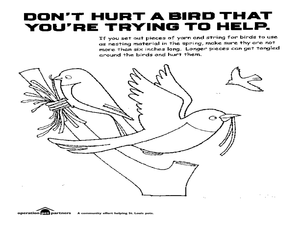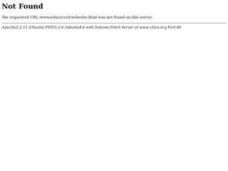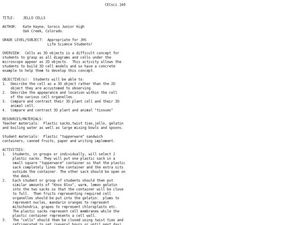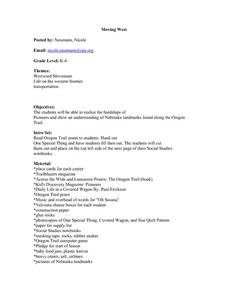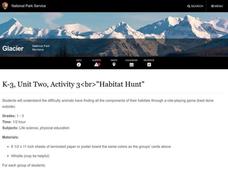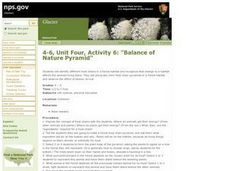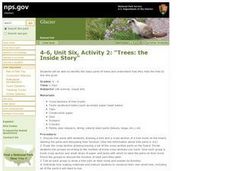Curated OER
This is for the Birds!
Learners complete activities to investigate wild birds. For this bird study lesson, students make a wild bird feeder to examine the proper ways to care for wild birds. Learners explore organizations in their community that help wild...
Curated OER
Current Events and Fish
Fifth graders examine current events impacting aquatic life in their communities. They search for newspaper, magazine and television reports for information about aquatic life in local bodies of water. Students can write letters to...
Curated OER
Rocking the Boat
Students work together to discover the concepts of stability and equilibrium. They examine how equilibrium is related to an item's center of mass. They create their own action scene in a literacy activity.
Curated OER
Ecosystem Organization - Lesson Plan
Student explore ecosystems. In this ecosystem organization lesson, students consider how scientists study living organisms. Students participate in a teacher guided activity that requires them to visualize an organism and imagine its...
Curated OER
Linking Lines to Landscape
Students evaluate art to enhance their core knowledge of fiction, American folk heroes, and the water cycle. In this art lesson, students complete a unit of activities to use art to study various topics of literature, history, and...
Curated OER
Compost Columns
In this unit of lessons, students examine the role of compost columns and recycling. They create a KWL chart about garbage in Chicago. They also examine life cycles and packaging of everyday products.
Curated OER
Investigating Animals in Soil
Young scholars investigate and observe small animal activity on a plot of land on their school grounds. In small groups they identify the five kingdoms of animals, stake out a small plot of ground, collect samples, record and analyze...
Curated OER
Long Live the Sharks and Rays
Students study shark and ray adaptations that have helped their survival. In this animal adaptations lesson students view a video and work in groups to research specific types of sharks and rays.
Curated OER
Jello Cells
Middle schoolers create a three dimensional model of a cell. In this cellular structure lesson, students use gelatin, plastic bags, plastic containers, and fruit to construct a model of a cell. They compare the cells structures and stack...
Curated OER
So You Think You're Tough
Fourth graders learn how to classify animals. In this invertebrates lesson, 4th graders discuss how we classify thinks into groups and move into a discussion about classifying animals. Students learn about the differences between...
Curated OER
Historical Markers
Students read the "Chicago Tribute Markers of Distinction," and pick one famous person to write about. In this creative writing worksheet, students write about this person's home. Additionally, students pretend that 100 years from now, a...
Curated OER
Moving West!
Young scholars explore, explain and experience the importance of good character traits in everyday life by assessing the challenging journeys traveled on the Oregon Trail. They study the daily accounts of perseverance and courage along...
Curated OER
Snug in the Snow
Students explore how snow helps animals survive in the wild. In this animal science lesson, students review key vocabulary words and discuss types of animal adaptations. Students construct shoebox to simulate the snowy environment where...
Curated OER
Track Stories
Young scholars identify animal tracks. In this animal track lesson, students look at "track stories" and identify the animals that made the tracks. Young scholars discuss if they believe the animals are predators or prey.
Curated OER
Habitat Hunt
Students discover how hard it is for animals to find all the items needed in their habitat. For this habitat lesson, students play a game in which they pretend to be an animal, they discover that not all animals can find the food needed...
Curated OER
What's That Habitat?
Fourth graders explore the environment by researching animal characteristics. For this habitat identification lesson, 4th graders utilize paper and crayons to illustrate their own habitats or homes and discuss what it contains that is...
Curated OER
Beaver Succession Mural
Students explore the concept of beaver pond succession. In this succession instructional activity, students discuss what succession is and how it works. Students create a mural to present their understanding of this concept.
Curated OER
Balance of Nature Pyramid
Students study the concept of food chains and create a physical forest food chain pyramid. In this balance of nature pyramid lesson, students identify the ingredients needed on each level of the pyramid then make connections...
Curated OER
Models of Succession
Young scholars create a model city in order to understand the effects human habitats have on the environment. For this environment lesson, students examine the effects human habitats have on the environment. Young scholars...
Curated OER
Trees: The Inside Story
Students explore trees. In this math lesson, students identify the basic parts of trees. Students create a model of a tree and label the parts.
Curated OER
Build A Tree
Students study the different parts of a tree and the significance of each part. In this build a tree lesson, students use role-playing theater to reinforce what they are learning. Students use their imagination to become tree parts...
American Museum of Natural History
Microbes Coloring Book and Scavenger Hunt
Coloring pages showcase microbes—bacteria, viruses, and protists. Scholars have the option to download a coloring book and scavenger hunt or color the page directly on the computer. Three paragraphs describe each microbe.
Curated OER
Healing Fallen Warriors
Students read ancient Greek texts to explore evidence for healing wounds and compare ancient healing practices to those of modern times.
Curated OER
Observation: It's A Natural!
Students play the role of naturalist in their own community just as Thoreau was in his. They observe their communities looking for positive and negative aspects on the environment. They work together in groups to complete a model for...
